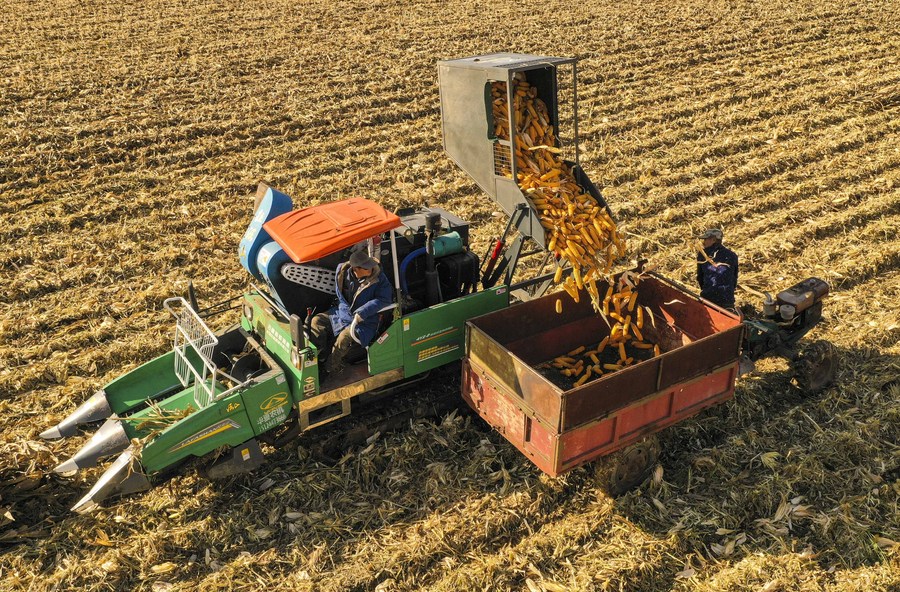
Aerial photo taken on Oct. 10, 2021 shows farmers harvesting corns in Huapichang Town of Jilin City, northeast China's Jilin Province. (Xinhua/Xu Chang)
CHANGCHUN, Dec. 25 (Xinhua) -- Northeast China's Jilin Province, an important commodity grain base in China, has been developing a modern agriculture system over the past years to build up strength in agriculture.
Thanks to its efforts, including black soil conservation, seed industry development, and industry chain upgrading, it has achieved record grain output in recent years.
In 2021, the grain output of Jilin exceeded 40 billion kg for the first time, with its growth rate ranking first among the top 10 grain-producing provinces in China. This year, Jilin launched a project which aims to achieve a comprehensive grain production capacity of 50 billion kg by 2030.
BLACK SOIL CONSERVATION
"In spring next year, the straws in the field won't need to be cleaned. No-till planters will be used for sowing. This way, the soil suffers from minimum disturbance," said Yang Qingkui, a grain farmer in Lishu County.
The mode with corn straws covering the land and the whole-process mechanized production technology as the core developed in the county has increased grain output and protected the black soil.
Since 2021, the Chinese Academy of Sciences (CAS), together with provinces in northeast China, has focused on technology in agriculture and built seven demonstration zones of 10,000 mu (about 666.67 hectares). Around 1,000 researchers with the CAS went to villages and provided technological support for black soil conservation in the province.
In the past two years, the conservational tillage areas have been extended by more than 10 million mu to 32.83 million mu, accounting for half of the province's corn plantation area.
Black soil is key to Jilin's grain production. More than 65 percent of the cultivated land in Jilin is black soil, and more than 80 percent of the grain is produced from black soil.
Jilin has paid great attention to black soil protection. Last year, the province rolled out 38 measures covering ten aspects in an implementation opinion on comprehensively strengthening black soil protection and established a multi-departmental joint protection mechanism to gather talents, funds, projects, and policies to protect black land.
The province has also been working on building high-standard farmland. Currently, among the 83 million mu of farmland in Jilin, more than 40 million mu has been developed into high-standard farmland.
"Since the establishment of high-standard farmland, over 2,000 yuan (about 286.2 U.S. dollars) can be saved, and production can be increased by 10 percent for every hectare of land," said Xu Yuqing, head of a cooperative in Yushu City.
SEED INDUSTRY
"The corn seeds we sow now are all developed domestically. They have high yield and strong disease resistance, performing better than foreign seeds," said Li Zhongyu, head of a cooperative in Nong'an County.
Ten years ago, foreign seeds occupied 70 percent of the market in the province. Jilin Province thus supported research institutes and companies to work together to develop seed resources, reducing the market share of foreign seeds to 2 percent.
Hongxiang Seed Industry, located in Fuyu City, is one of the seed distribution companies. It only had two corn varieties and one researcher. With the support of the local government, it has carried out breeding cooperation with nine top corn breeding teams in China, with an annual investment of more than 50 million yuan in research. At present, it has more than 100 corn varieties, producing 30 million kg of corn seeds annually, and the various promotion covers 26 provinces.
In recent years, Jilin has also accelerated the creation and application of advanced agricultural machinery. The overall mechanization level of major crops has reached 93 percent, 20 percentage points higher than the national average.
"Smart agricultural machinery saves manpower and can work day and night, improving farming efficiency," said Zhang Wendi, a grain farmer in Lishu County who owns an unmanned harvester that automatically runs along the designated route to harvest corn in the field.
INDUSTRY CHAIN UPGRADING
After the process, including cutting, cleaning, cooking, and bagging at the workshop of the Dele agricultural cooperative association, the fresh corn will be sold across the country.
"The market price of an ear of organic fresh corn is several times that of ordinary corn," said Li Dele, head of the cooperative association. The association has led more than 2,000 households of farmers to adjust their planting varieties, planting more than 300 hectares of fresh corn and increasing their income by more than 5,000 yuan per hectare.
In recent years, Jilin has made great efforts to build modern agricultural industrial, production, and management systems, pushing forward the upgrading of the industry chain.
The province has also established harvest food service centers to promote industrial management.
Farmers at the Yongxin cooperative in Tiexi District, Siping City, loaded nearly 2,000 tonnes of harvested corn and transported them to the local service center for storage.
"In the past, due to limited space, corn was simply placed in the fields after the autumn harvest, resulting in a large amount of food loss every year. Now we have the service centers, providing food drying, storage, sales, and other services," said Hou Gang, head of the cooperative, adding that the corn will be sold when they fetch a reasonable price to ensure income increase.
So far, such service centers cover major grain production counties in the province, with the cumulative service volume reaching more than 10 million tonnes.




 A single purchase
A single purchase









